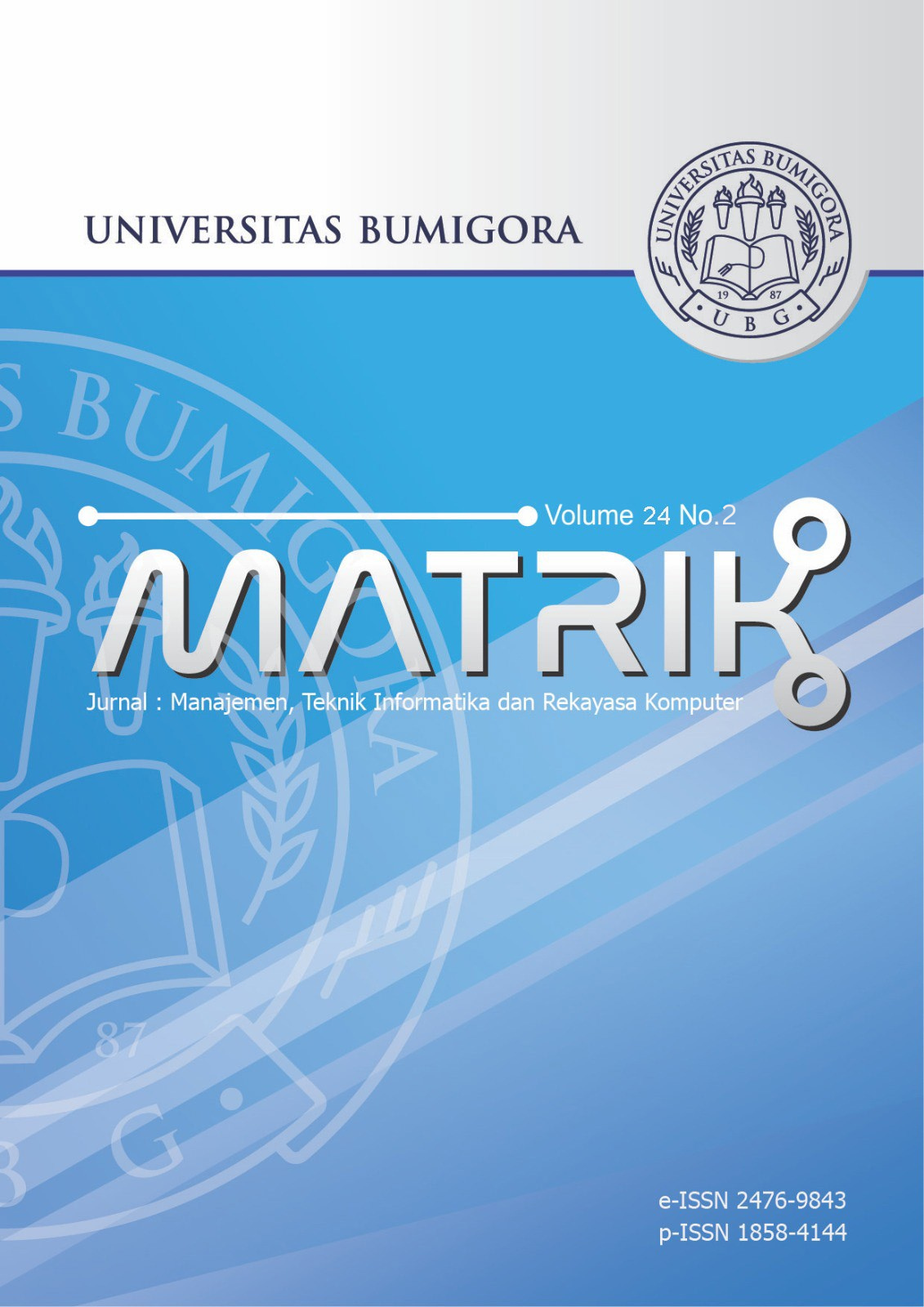Integration of Image Enhancement Technique with DenseNet201 Architecture for Identifying Grapevine Leaf Disease
DOI:
https://doi.org/10.30812/matrik.v24i2.4137Keywords:
Convolutional Neural Network, DenseNet201, Deep learning, Image Classification, Image Enhancement, Leaf Disease DetectionAbstract
Early detection of grapevine leaf diseases is crucial for maintaining both the quality and quantity of grape production. Manual identification methods are often ineffective and prone to errors. This research aims to develop a precise and efficient method for classifying grapevine leaf diseases using Contrast Limited Adaptive Histogram Equalization (CLAHE) and the DenseNet201 Deep Convolutional Neural Network (DCNN) architecture. The research methodology involves collecting a dataset of grapevine leaf images affected by black measles, black rot, and leaf blight alongside healthy leaves. Following this, preprocessing is conducted using the CLAHE technique to enhance image quality. Then, the processed data is trained with DenseNet201. Evaluation results indicate that the proposed model achieves an overall accuracy of 99.61%, with high precision, recall, and F1-score values across all disease classes. Receiver Operating Characteristic (ROC) curve analysis shows an Area Under the Curve (AUC) of 1.00 for each class, reflecting excellent discriminatory ability. The loss and accuracy curves illustrate consistent model performance without signs of overfitting. Additionally, the confusion matrix confirms very low classification error rates. The developed model is effective and reliable for identifying grapevine leaf diseases. Future research will focus on enhancing the dataset by incorporating more data optimizing hyperparameters, and developing field applications for real-time use.
Downloads
References
and machine learning,†Smart Agricultural Technology, vol. 3, no. March 2022, p. 100081, 2023, https://doi.org/10.1016/
j.atech.2022.100081.
[2] S. S. Harakannanavar, J. M. Rudagi, V. I. Puranikmath, and A. Siddiqua, “Plant leaf disease detection using computer vision
and machine learning algorithms,†Global Transitions Proceedings journal, vol. 3, no. April, pp. 305–310, 2022, https://doi.
org/10.1016/j.gltp.2022.03.016.
[3] P. V. Yeswanth, S. Deivalakshmi, S. George, and S.-B. Ko, “Residual Skip Network-Based Super-Resolution for Leaf Disease
Detection of Grape Plant,†Circuits, Systems, and Signal Processing, vol. 42, no. 11, pp. 6871–6899, 2023, https://doi.org/10.
1007/s00034-023-02430-2.
[4] Z. Huang, A. Qin, J. Lu, A. Menon, and J. Gao, “Grape Leaf Disease Detection and Classification Using Machine
Learning,†in IEEE/ACM Int’l Conference on & Int’l Conference on Cyber, Physical and Social Computing
(CPSCom) Green Computing and Communications (GreenCom), 2020, pp. 870–877, https://doi.org/10.1109/
iThings-GreenCom-CPSCom-SmartData-Cybermatics50389.2020.00150.
[5] Y. Peng, S. Zhao, and J. Liu, “Fused-Deep-Features Based Grape Leaf Disease Diagnosis,†Agronomy, vol. 11, no. 11, pp. 1–17,
2021, https://doi.org/10.3390/agronomy11112234.
[6] R. Dwivedi, S. Dey, C. Chakraborty, and S. Tiwari, “Grape Disease Detection Network based on Multi-task Learning and
Attention Features,†IEEE Sensors Journal, vol. 21, no. 16, pp. 1–8, 2021, https://doi.org/10.1109/JSEN.2021.3064060.
[7] R. Nagi and S. S. Tripathy, “Deep convolutional neural network based disease identification in grapevine leaf images,†Multimedia
Tools and Applications, vol. 81, no. 18, pp. 24 995–25 006, 2022, https://doi.org/10.1007/s11042-022-12662-0.
[8] R. M. Math and N. V. Dharwadkar, “Early detection and identification of grape diseases using convolutional neural networks,â€
Journal of Plant Diseases and Protection, vol. 129, no. 3, pp. 521–532, 2022, https://doi.org/10.1007/s41348-022-00589-5.
[9] M. Shantkumari and S. V. Uma, “Grape leaf segmentation for disease identification through adaptive Snake algorithm model,â€
Multimedia Tools and Applications, vol. 80, November, pp. 8861–8879, 2020, https://doi.org/10.1007/s11042-020-09853-y.
[10] Z. Zinonos, S. Gkelios, and A. L. A. F. Khalifeh, “Grape Leaf Diseases Identification System Using Convolutional Neural
Networks and LoRa Technology,†IEEE Access, vol. 10, Desember, pp. 122–133, 2022, https://doi.org/10.1109/ACCESS.2021.
3138050.
[11] V. K. Vishnoi, K. Kumar, and B. Kumar, “Plant disease detection using computational intelligence and image processing,â€
Journal of Plant Diseases and Protection, vol. 128, no. 1, pp. 19–53, 2021, https://doi.org/10.1007/s41348-020-00368-0.
[12] J. Zhu and A. Wu, “Identification of grape diseases using image analysis and BP neural networks,†Multimedia Tools and
Applications, vol. 79, January, pp. 14 539–14 551, 2019, https://doi.org/10.1007/s11042-018-7092-0.
[13] B. I. N. Liu, C. Tan, S. Li, J. He, and H. Wang, “A Data Augmentation Method Based on Generative Adversarial Networks for
Grape Leaf Disease Identification,†IEEE Access, vol. 8, June, pp. 102 188–102 198, 2020, https://doi.org/10.1109/ACCESS.
2020.2998839.
[14] M. Ji, L. Zhang, and Q. Wu, “Automatic grape leaf diseases identification via UnitedModel based on multiple convolutional
neural networks,†Information Processing in Agriculture, vol. 7, no. 3, pp. 418–426, 2020, https://doi.org/10.1016/j.inpa.2019.
10.003.
[15] S. Lauguico and E. Dadios, “Grape Leaf Multi-disease Detection with Confidence Value Using Transfer Learning Integrated
to Regions with Convolutional Neural Networks,†in 2020 IEEE Region 10 Conference (Tencon), 2020, pp. 767–772, https:
//doi.org/10.1109/TENCON50793.2020.9293866.
[16] C. Zhou, Z. Zhang, S. Zhou, J. Xing, Q. Wu, and J. I. A. Song, “Grape Leaf Spot Identification Under Limited Samples by Fine
Grained-GAN,†IEEE Access, vol. 9, pp. 100 480–100 489, 2021, https://doi.org/10.1109/ACCESS.2021.3097050.
[17] W. Guo, Q. Feng, X. Li, S. Yang, and J. Yang, “Grape leaf disease detection based on attention mechanisms,†Int J Agric & Biol
Eng, vol. 15, no. 5, pp. 205–212, 2022, https://doi.org/10.25165/j.ijabe.20221505.7548.
[18] H. Jin, Y. Li, J. Qi, J. Feng, D. Tian, andW. Mu, “GrapeGAN: Unsupervised image enhancement for improved grape leaf disease
recognition,†Computers and Electronics in Agriculture, vol. 198, July, p. 107055, 2022, https://doi.org/10.1016/j.compag.2022.
107055.
[19] J. Lin, X. Chen, R. Pan, T. Cao, J. Cai, Y. Chen, X. Peng, T. Cernava, and X. Zhang, “GrapeNet : A Lightweight Convolutional
Neural Network Model for Identification of Grape Leaf Diseases,†Agriculture (Switzerland), vol. 12, no. 6, 2022, https://doi.
org/10.3390/agriculture12060887.
[20] S. P. Praveen, R. Nakka, A. Chokka, V. N. Thatha, S. S. Vellela, and U. Sirisha, “A Novel Classification Approach for Grape
Leaf Disease Detection Based on Different Attention Deep Learning Techniques,†(IJACSA) International Journal of Advanced
Computer Science and Applications, vol. 14, no. 6, pp. 1199–1209, 2023, https://doi.org/10.14569/IJACSA.2023.01406128.
[21] T. Lu, B. Han, L. Chen, F. Yu, and C. Xue, “A generic intelligent tomato classification system for practical applications using
DenseNet-201 with transfer learning,†Scientific Reports, pp. 1–8, 2021, https://doi.org/10.1038/s41598-021-95218-w.
[22] N. Paul, G. C. Sunil, D. Horvath, and X. Sun, “Deep learning for plant stress detection : A comprehensive review of technologies
, challenges , and future directions,†Computers and Electronics in Agriculture, vol. 229, no. July 2024, p. 109734, 2025,
https://doi.org/10.1016/j.compag.2024.109734.
[23] G. Geetharamani and A. P. J, “Identification of plant leaf diseases using a nine-layer deep convolutional neural network,â€
Computers and Electrical Engineering, vol. 76, pp. 323–338, 2019, https://doi.org/10.1016/j.compeleceng.2019.04.011.
[24] C. C. Ukwuoma, Z. Qin, B. Bin, F. Akhtar, O. Bamisile, A. Y. Muaad, D. Addo, and M. A. Al-antari, “A Hybrid Explainable
Ensemble Transformer Encoder for Pneumonia Identification from Chest X-ray Images,†Journal of Advanced Research, vol. 48,
pp. 191–211, 2023, https://doi.org/10.1016/j.jare.2022.08.021.
[25] C. C. Ukwuoma, D. Cai, B. Bin, O. Bamisile, H. Adun, Z. Al-huda, and M. A. Al-antari, “Deep Learning Framework for Rapid
and Accurate Respiratory COVID-19 Prediction using Chest X-ray Images,†Journal of King Saud University - Computer and
Information Sciences, vol. 35, no. 7, p. 101596, 2023, https://doi.org/10.1016/j.jksuci.2023.101596.
[26] P. H¨artinger and C. Steger, “Adaptive histogram equalization in constant time,†Journal of Real-Time Image Processing, vol. 21,
no. 3, p. 93, 2024, https://doi.org/10.1007/s11554-024-01465-1.
[27] C. Shorten and T. M. Khoshgoftaar, “A survey on Image Data Augmentation for Deep Learning,†Journal of Big Data, vol. 6,
no. 1, 2019, https://doi.org/10.1186/s40537-019-0197-0.
[28] G. Huang, Z. Liu, and L. V. D. Maaten, “Densely Connected Convolutional Networks,†in Proceedings of the IEEE conference
on computer vision and pattern recognition, 2017, https://doi.org/10.48550/arXiv.1608.06993.
[29] L. S. Bernardo, R. Damaˇseviˇcius, V. H. C. De Albuquerque, and R. Maskeli¯unas, “A Hybrid Two-stage SqueezeNet and Support
Vector Machine System for Parkinson’s Disease Detection based on Handwritten Spiral Patterns,†International Journal of
Applied Mathematics and Computer Science, vol. 31, no. 4, pp. 549–561, 2021, https://doi.org/10.34768/amcs-2021-0037.
[30] P. B. Le, “ROC Curves , Loss Functions , and Distorted Probabilities in Binary Classification,†Mathematics, vol. 10, no. 9, pp.
1–13, 2022, https://doi.org/10.3390/math10091410.
[31] M. P. Niroomand, C. T. Cafolla, J. W. R. Morgan, and D. J. Wales, “Characterising the area under the curve loss function
landscape,†Machine learning science and technology, vol. 3, no. 1, pp. 1–15, 2022, https://doi.org/10.1088/2632-2153/ac49a9.
Matrik: Jurnal
Downloads
Published
Issue
Section
How to Cite
Similar Articles
- Muhammad Rizki, Arief Hermawan, Donny Avianto, Learning Accuracy with Particle Swarm Optimization for Music Genre Classification Using Recurrent Neural Networks , MATRIK : Jurnal Manajemen, Teknik Informatika dan Rekayasa Komputer: Vol. 23 No. 2 (2024)
- Fitra Ahya Mubarok, Mohammad Reza Faisal, Dwi Kartini, Dodon Turianto Nugrahadi, Triando Hamonangan Saragih, Gender Classification of Twitter Users Using Convolutional Neural Network , MATRIK : Jurnal Manajemen, Teknik Informatika dan Rekayasa Komputer: Vol. 23 No. 1 (2023)
- Tjut Awaliyah Zuraiyah, Sufiatul Maryana, Asep Kohar, Automatic Door Access Model Based on Face Recognition using Convolutional Neural Network , MATRIK : Jurnal Manajemen, Teknik Informatika dan Rekayasa Komputer: Vol. 22 No. 1 (2022)
- Achmad Lukman, Wahju Tjahjo Saputro, Erni Seniwati, Improving Performance Convolutional Neural Networks Using Modified Pooling Function , MATRIK : Jurnal Manajemen, Teknik Informatika dan Rekayasa Komputer: Vol. 23 No. 2 (2024)
- Firda Yunita Sari, Maharani sukma Kuntari, Hani Khaulasari, Winda Ari Yati, Comparison of Support Vector Machine Performance with Oversampling and Outlier Handling in Diabetic Disease Detection Classification , MATRIK : Jurnal Manajemen, Teknik Informatika dan Rekayasa Komputer: Vol. 22 No. 3 (2023)
- Reo Wicaksono, Didik Dwi Prasetya, Ilham Ari Elbaith Zaeni, Nadindra Dwi Ariyanta, Tsukasa Hirashima, Machine Learning for Open-ended Concept Map Proposition Assessment: Impact of Length on Accuracy , MATRIK : Jurnal Manajemen, Teknik Informatika dan Rekayasa Komputer: Vol. 25 No. 1 (2025)
- Siti Ummi Masruroh, Andrew Fiade, Muhammad Ikhsan Tanggok, Rizka Amalia Putri, Luigi Ajeng Pratiwi, Convolutional Neural Network for Colorization of Black and White Photos , MATRIK : Jurnal Manajemen, Teknik Informatika dan Rekayasa Komputer: Vol. 22 No. 2 (2023)
- Alya Masitha, Muhammad Kunta Biddinika, Herman Herman, K Value Effect on Accuracy Using the K-NN for Heart Failure Dataset , MATRIK : Jurnal Manajemen, Teknik Informatika dan Rekayasa Komputer: Vol. 22 No. 3 (2023)
- Ahmad Naufal Labiib Nabhaan, Rakandhiya Daanii Rachmanto, Arief Setyanto, Characterizing Hardware Utilization on Edge Devices when Inferring Compressed Deep Learning Models , MATRIK : Jurnal Manajemen, Teknik Informatika dan Rekayasa Komputer: Vol. 24 No. 1 (2024)
- Sri Suwarno, Erick Kurniawan, Multi-Level Pooling Model for Fingerprint-Based Gender Classification , MATRIK : Jurnal Manajemen, Teknik Informatika dan Rekayasa Komputer: Vol. 22 No. 2 (2023)
You may also start an advanced similarity search for this article.


.png)












